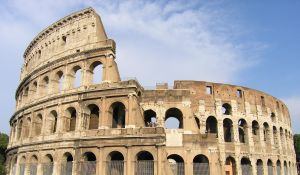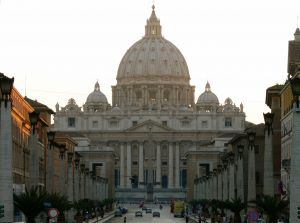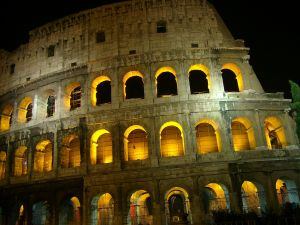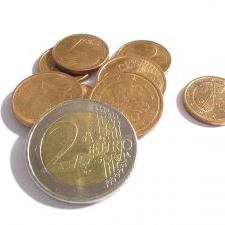 Rome is truly a city of many wonders.
Rome is truly a city of many wonders.
Between the ancient ruins of the Forum Romanum, the cradle of modern society, and the indescribable grandeur of the Vatican City, it’s no wonder that Rome is among the most visited destinations in the world.
Of course, it’s practically a given that where there are travelers, there are people looking to take advantage of them.
So check out these Roman treasures and learn how to avoid its pitfalls.
Visiting the Vatican
Lines at the Vatican Museums can be mind boggling. If you go first thing in the morning, you are likely to encounter waits of between two and three hours, with the line wrapping around for nearly a mile from the museums’ entrance back towards Piazza San Pietro.
There are two ways to save yourself the time and trouble:
 You can pay (about €25 per person) for a guided tour which you can pick up at the last minute in Piazza San Pietro. These last-minute tours involve hawkers soliciting clients in the piazza, guides and a rather formal pecking order, but may remind you of a circus.
You can pay (about €25 per person) for a guided tour which you can pick up at the last minute in Piazza San Pietro. These last-minute tours involve hawkers soliciting clients in the piazza, guides and a rather formal pecking order, but may remind you of a circus.
There are a couple of drawbacks to this method. The first is that these guided tours generally last about 90 minutes, which not enough to see everything in the Vatican Museums. However, at the end of the tour, in the Sistine Chapel, you will have the choice to exit either to the left, back into the museums to see more of the collections, or to the right, out towards the Basilica San Pietro (where you can also get in line to either climb the dome of Saint Peter’s or to see the Papal Crypts).
One thing to keep in mind is that you are, in fact, soliciting illegal services. Chances are that the tour will go off without a hitch or, in the worse case scenario, the guide will be caught and you will lose your €25. If you do choose to take this route (as do several hundred, if not thousands, of tourists per day) you will be able to sit comfortably in a café and enjoy a cappuccino while your guide waits in line for you.
The second method is unbelievably simple: Since the masses flock to the museum in the morning, be a contrarian and go in the afternoon. If you go around 1 p.m., the wait should be less than half an hour. If you go at 2 p.m., there should be practically no wait at all. Once there, you can guide yourself as you please using the audio guide.
This plan, however, though it will work nine times out of ten, is not infallible. Since the museums are closed on Sunday, Monday is the worst day to plan your visit since there is often two days’ worth of crowds. There are also just fluke days, particularly during the high tourist month of July, when the museums are simply crowded all day.
Also, keep in mind that on most days, the museums close at 4:30 (ticket sales stop at 3:30) so the later you go, the shorter the lines, but also the less time you have to wonder through the seemingly endless rooms of art from every genre and century. (Definitely consult the museums’ Web site for the hours the day you intend to visit)
Also consider the fact that, even though the Vatican is technically a different country, it is entirely within Italy and hence staffed mostly by Italians. Therefore, don’t be surprised if they start hustling you out of the Sistine Chapel on the 4:15 p.m. side of 4:30 p.m. Between 1:30 p.m. and 2 p.m. is really the optimal time to go.
 The Colosseum’s Best-Kept Secret
The Colosseum’s Best-Kept Secret
Another place where travelers often needlessly lose hours is waiting in line at the Colosseum. This amazing monument is surely worth seeing from the inside, but why wait in line if you don’t have to?
It is a little-known fact that tickets purchased for the Colosseum are also valid for the Palatine Hill and vice versa. The Palatine Hill, another fascinating but much less frequented sight, has its own ticket booth where the line is generally negligible or non-existent.
To reach this ticket booth from the Colosseum, pass in front of the Arch of Constantine, walk up the Via Sacra and to the left of the Arch of Titus. Continue past the green booth (which sells audio guides) and down to the end of this short path where, on the left, you will find the Palatine Hill ticket booth.
The five minutes it will take you to walk there and back can save you hours worth of waiting inside the Colosseum. You will still have to wait in line outside to pass through the metal detectors, but once inside, enjoy the VIP feeling you get breezing past the long line of tourists waiting for tickets (pass on the left).
Avoiding the Tourist Traps
It’s an unfortunate reality that overpriced and/or mediocre restaurants invariably spring up all around Rome’s most visited attractions. A general word to the wise is to never eat in restaurants where the waiters are standing outside trying to coax you in (“Prego, prego, buona sera, prego…”). It’s worth effort to walk 5-10 minutes outside these tourist centers to find a better meal.
 That being said, it is truly difficult to find a good, reasonably priced restaurant anywhere within a mile radius of the Vatican City. After visiting the Vatican, invest in a five minute cab ride to the nearby Trastevere neighborhood which abounds with good restaurants and cute shops. It’s hard to go wrong among the quaint Trastevere eateries, but in the small Piazza de Renzi in particular, there are two great places within a stone’s throw of one another. The first is called Casetta di Trastevere (“Little House of Trastevere”) which boasts charming ambiance and a to-die-for tiramisu. The other is called Da Augusto which exudes a traditional cucina romana-style charm. In either of these places you are guaranteed a great meal at a reasonable price, a million times better than what you’d eat if you stop in the first place you see when exiting the Vatican.
That being said, it is truly difficult to find a good, reasonably priced restaurant anywhere within a mile radius of the Vatican City. After visiting the Vatican, invest in a five minute cab ride to the nearby Trastevere neighborhood which abounds with good restaurants and cute shops. It’s hard to go wrong among the quaint Trastevere eateries, but in the small Piazza de Renzi in particular, there are two great places within a stone’s throw of one another. The first is called Casetta di Trastevere (“Little House of Trastevere”) which boasts charming ambiance and a to-die-for tiramisu. The other is called Da Augusto which exudes a traditional cucina romana-style charm. In either of these places you are guaranteed a great meal at a reasonable price, a million times better than what you’d eat if you stop in the first place you see when exiting the Vatican.
Quite near Rome’s ancient ruins (the Forum Romanum, the Imperial Forums, and the Colosseum) is a neighborhood called Monti, which, despite its proximity, has somehow been miraculously preserved from hordes of tourists, thus, again, the food is better and the prices lower. The main street of this neighborhood is called Via dei Serpenti, which winds down between Via Nazionale and Via Cavour. The intersecting streets are jam packed with great restaurants, gelaterias, and pizzerias.
One restaurant to top all others is La Taverna dei Fori Imperiali located at Via Madonna dei Monti. Here you will find a menu filled with traditional Roman dishes accented by piatti del giorno (daily specials) that frequently put new spins on old favorites, such as a new take on the traditional carbonara dish which substitutes swordfish for pancetta, making the dish lighter and imbuing it with a savory flavor. Their putanesca is phenomenal. Two pleasant side notes: it is family-owned and operated and they have very clean restrooms!
Eating near the Spanish Steps and the Trevi Fountain can be a bit trickier. Here, even the pizzerias tend to be overpriced. If you’re willing to walk for a bit, stroll across Via del Corso over to Piazza del Augusto Imperatore where you’ll find the ristorante/pizzeria/enoteca ‘Gusto.
This amazing locale, frequented mostly by native Romans, is set in a piazza constructed by Mussolini around the giant mausoleum of the Rome’s first emperor, Augustus. But this fascinating setting is the least of what draws diners to ‘Gusto. Their menu features new Italian cuisine, based off of traditional Roman cuisine but highlighted and accented with modern innovation. Their wine list is extensive, to say the least.
A Little Tip
 Frequently on the bill (il conto) at a restaurant or if you take a table at a snack bar, you will see a service/table charge of one or two euro per person. Basically they are charging you for the bread and use of the silverware.
Frequently on the bill (il conto) at a restaurant or if you take a table at a snack bar, you will see a service/table charge of one or two euro per person. Basically they are charging you for the bread and use of the silverware.
Bear in mind, however, that tipping is not necessary or even common in Italy. It’s not like in the U.S. where the waiters make a lower minimum wage because the government factors tips into their earnings. To leave a tip in Italy is like to say a little extra grazie. If the bill is €37 and you leave €40, it would be looked upon as sufficient or even generous.
If you have an extraordinary waiter who suggests a dish which blows you away and which you would never have thought to order and who also suggests the perfect wine to compliment that dish, leave him 10 percent and he will go home happy.
Taste of Tradition
 Italy will always be famous for its delicious ice cream, gelato.
Italy will always be famous for its delicious ice cream, gelato.
It seems like there is a gelateria every 50 feet in Rome (interspersed, of course, between cafés and pizzerias). For the most part, they are all delicious, but one way to tell if a gelateria is a step above the rest is based on their pistachio-flavored gelato. A pistachio too sweet or creamy (usually marked by a washed out, pale green color) is the mark of an inferior gelateria. A pistachio done right has a deeper green color and it’s always a plus if there are bits of actual pistachio nuts in there too.
One great gelateria is located at Via Benedetta, 6. Their selection is small, but optimal, including, of course, a pistachio done just right.
Italians rarely drink a cappuccino or café latte after a meal. Italians eat their salad at the end of the meal, rather than the beginning (it’s all about the roughage). This also explains their traditional after dinner drinks (called, in Italian, digestivi), such as limoncello or any of various amari (bitter drinks served in shot-sized glasses but intended to be sipped).
Then again, when in Rome, do as you please. If you want a cappuccino after dinner, who cares if the waiter sniggers at you behind your back?
By Rachel B. Harrison for PeterGreenberg.com. Rachel Harrison has a degree from Emory University in Classical Studies. She spent summer 2007 working as a tour guide in Rome.
Looking for more great Italy travel ideas? Check out our Report From Maratea, Italy.
Or find out how they celebrate Christmas in Italy–and how you can join in.
Interested in learning Italian? Find out how to take an Immersive Language Vacation in Italy for the Whole Family.
Check out more cities from our Off the Brochure Travel Guide Series:












